Satellite-Based Machine Learning for Soil Moisture Prediction and Land Conservation Practice Assessment in West African Drylands
Highlights
- Integration of SMAP, Sentinel-2, and WaPOR data through LSTM modeling enabled accurate daily soil moisture prediction across fragmented smallholder landscapes in semiarid northern Ghana.
- Stone bunds presented consistent soil moisture enhancement across multiple years, terrain types, and seasons, with benefits most pronounced on steeper slopes and in areas with lower topographic wetness.
- The modeling framework provides a transferable approach for monitoring soil–water dynamics in data-sparse dryland regions where traditional monitoring infrastructure is absent.
- Model-enhanced satellite observations of soil moisture enable quantification of conservation practice effectiveness, supporting evidence-driven scaling of nature-based solutions for climate adaptation in vulnerable agricultural systems.
Abstract
1. Introduction
- (i)
- Generate daily soil moisture predictions via LSTM networks trained on spatially downscaled remote sensing inputs;
- (ii)
- Fine-scale spatial heterogeneity in soil moisture across fragmented, semiarid landscapes is captured;
- (iii)
- Quantify the spatiotemporal impacts of stone bunds on soil moisture retention across 222 field sites in northern Ghana.
2. Materials and Methods
2.1. Study Area
- Stone-bunded fields (S): plots bordered by contour-aligned stone bunds designed to reduce runoff and enhance infiltration.
- Non-bunded fields (N): adjacent or nearby control plots lacking physical soil and water conservation structures.
2.2. Data
2.2.1. Ground-Based Data: In Situ Measurements
2.2.2. Remote Sensing Data and Analyses
Terrain Data Acquisition and Analysis
Soil Moisture Data Acquisition and Processing
NDVI Data Acquisition and Processing
AETI Data Acquisition and Processing
Raster Harmonization and Point-Data Extraction
2.3. Model Development
2.3.1. Model Selection and Data Preprocessing
2.3.2. LSTM Model Architecture and Hyperparameter Optimization
2.3.3. Model Application and Evaluation
3. Results
3.1. Data Evaluation and Refinement
3.1.1. Dataset Selection and Downscaling
3.1.2. Relationships Between Predictors and Observed Soil Moisture
3.2. Evaluation of the Soil Moisture Prediction Model
3.2.1. Model Performance Evaluation
3.2.2. Spatiotemporal Evaluation of Model Performance
3.3. Model Performance in the Stone Bund and Control Areas
3.3.1. Temporal Assessment
3.3.2. Spatial Assessment
3.3.3. Topographic Controls on Predicted Soil Moisture
4. Discussion
4.1. Data Integration and Preprocessing
4.2. Model Performance and Predictors
4.3. Stone-Bund Impact and Implications
5. Conclusions
Author Contributions
Funding
Data Availability Statement
Acknowledgments
Conflicts of Interest
References
- McColl, K.A.; Alemohammad, S.H.; Akbar, R.; Konings, A.G.; Yueh, S.; Entekhabi, D. The Global Distribution and Dynamics of Surface Soil Moisture. Nat. Geosci. 2017, 10, 100–104. [Google Scholar] [CrossRef]
- Dobriyal, P.; Qureshi, A.; Badola, R.; Hussain, S.A. A Review of the Methods Available for Estimating Soil Moisture and Its Implications for Water Resource Management. J. Hydrol. 2012, 458–459, 110–117. [Google Scholar] [CrossRef]
- Schubert, S.; Dole, R.; vandenDool, H.; Suarez, M.; Waliser, D. Prospects for Improved Forecasts of Weather and Short-Term Climate Variability on Subseasonal (2-Week to 2-Month) Times Scales; NASA: Washington, DC, USA, 2002. [Google Scholar]
- Bolten, J.D.; Crow, W.T.; Zhan, X.; Jackson, T.J.; Reynolds, C.A. Evaluating the Utility of Remotely Sensed Soil Moisture Retrievals for Operational Agricultural Drought Monitoring. IEEE J. Sel. Top. Appl. Earth Obs. Remote Sens. 2009, 3, 57–66. [Google Scholar] [CrossRef]
- Sheffield, J.; Goteti, G.; Wen, F.; Wood, E.F. A Simulated Soil Moisture Based Drought Analysis for the United States. J. Geophys. Res. Atmos. 2004, 109, D24108. [Google Scholar] [CrossRef]
- Western, A.W.; Grayson, R.B.; Blöschl, G. Scaling of Soil Moisture: A Hydrologic Perspective. Annu. Rev. Earth Planet. Sci. 2002, 30, 149–180. [Google Scholar] [CrossRef]
- Kannenberg, S.A.; Anderegg, W.R.; Barnes, M.L.; Dannenberg, M.P.; Knapp, A.K. Dominant Role of Soil Moisture in Mediating Carbon and Water Fluxes in Dryland Ecosystems. Nat. Geosci. 2024, 17, 38–43. [Google Scholar] [CrossRef]
- Robinson, D.A.; Campbell, C.S.; Hopmans, J.W.; Hornbuckle, B.K.; Jones, S.B.; Knight, R.; Ogden, F.; Selker, J.; Wendroth, O. Soil Moisture Measurement for Ecological and Hydrological Watershed-scale Observatories: A Review. Vadose Zone J. 2008, 7, 358–389. [Google Scholar] [CrossRef]
- Loucks, D.P.; Van Beek, E. Water Resources Planning and Management: An Overview. In Water Resource Systems Planning and Management; Springer International Publishing: Cham, Switzerland, 2017; pp. 1–49. ISBN 978-3-319-44232-7. [Google Scholar]
- Sinore, T.; Wang, F. Impact of Climate Change on Agriculture and Adaptation Strategies in Ethiopia: A Meta-Analysis. Heliyon 2024, 10, e26103. [Google Scholar] [CrossRef]
- Togneri, R.; Felipe dos Santos, D.; Camponogara, G.; Nagano, H.; Custódio, G.; Prati, R.; Fernandes, S.; Kamienski, C. Soil Moisture Forecast for Smart Irrigation: The Primetime for Machine Learning. Expert Syst. Appl. 2022, 207, 117653. [Google Scholar] [CrossRef]
- Ritchie, H. Increasing Agricultural Productivity Across Sub-Saharan Africa Is One of the Most Important Problems This Century; WorldInData.org; MedBox: Laguna Hills, CA, USA, 2022. [Google Scholar]
- Tefera, M.L.; Giovanna Seddaiu; Alberto Carletti; Awada, H. Rainfall Variability and Drought in West Africa: Challenges and Implications for Rainfed Agriculture. Theor. Appl. Climatol. 2024, 156, 41. [Google Scholar] [CrossRef]
- Sungmin, O.; Orth, R. Global Soil Moisture Data Derived through Machine Learning Trained with In-Situ Measurements. Sci. Data 2021, 8, 170. [Google Scholar] [CrossRef]
- Moran, M.S.; Peters-Lidard, C.D.; Watts, J.M.; McElroy, S. Estimating Soil Moisture at the Watershed Scale with Satellite-Based Radar and Land Surface Models. Can. J. Remote Sens. 2004, 30, 805–826. [Google Scholar] [CrossRef]
- Romano, N. Soil Moisture at Local Scale: Measurements and Simulations. J. Hydrol. 2014, 516, 6–20. [Google Scholar] [CrossRef]
- Batjes, N.H. Harmonized Soil Property Values for Broad-Scale Modelling (WISE30sec) with Estimates of Global Soil Carbon Stocks. Geoderma 2016, 269, 61–68. [Google Scholar] [CrossRef]
- Vergopolan, N.; Chaney, N.W.; Pan, M.; Sheffield, J.; Beck, H.E.; Ferguson, C.R.; Torres-Rojas, L.; Sadri, S.; Wood, E.F. SMAP-HydroBlocks, a 30-m Satellite-Based Soil Moisture Dataset for the Conterminous US. Sci. Data 2021, 8, 264. [Google Scholar] [CrossRef]
- Peng, J.; Albergel, C.; Balenzano, A.; Brocca, L.; Cartus, O.; Cosh, M.H.; Crow, W.T.; Dabrowska-Zielinska, K.; Dadson, S.; Davidson, M.W.J.; et al. A Roadmap for High-Resolution Satellite Soil Moisture Applications—Confronting Product Characteristics with User Requirements. Remote Sens. Environ. 2021, 252, 112162. [Google Scholar] [CrossRef]
- Skulovich, O.; Gentine, P. A Long-Term Consistent Artificial Intelligence and Remote Sensing-Based Soil Moisture Dataset. Sci. Data 2023, 10, 154. [Google Scholar] [CrossRef]
- Vadez, V.; Grondin, A.; Chenu, K.; Henry, A.; Laplaze, L.; Millet, E.J.; Carminati, A. Crop Traits and Production under Drought. Nat. Rev. Earth Environ. 2024, 5, 211–225. [Google Scholar] [CrossRef]
- Naazie, G.K.; Dakyaga, F.; Derbile, E.K. Agro-Ecological Intensification for Climate Change Adaptation: Tales on Soil and Water Management Practices of Smallholder Farmers in Rural Ghana. Discov. Sustain. 2023, 4, 27. [Google Scholar] [CrossRef]
- Singh, R. Bunds. In Soil and Water Conservation Structures Design; Water Science and Technology Library; Springer Nature: Singapore, 2023; Volume 123, pp. 95–119. ISBN 978-981-19-8664-2. [Google Scholar]
- Tefera, M.L.; Awada, H.; Pirastru, M.; Kombiok, J.M.; Adjebeng-Danquah, J.; Adombilla, R.; Asungre, P.A.; Mahama, G.; Carletti, A.; Seddaiu, G. Remote Sensing and Field Data Analysis to Evaluate the Impact of Stone Bunds on Rainfed Agriculture in West Africa. Land 2024, 13, 1654. [Google Scholar] [CrossRef]
- Alemayehu, M.; Yohannes, F.; Dubale, P. Effect of Indigenous Stone Bunding (Kab) on Crop Yield at Mesobit-Gedeba, North Shoa, Ethiopia. Land Degrad. Dev. 2006, 17, 45–54. [Google Scholar] [CrossRef]
- Meresa, M.; Tadesse, M.; Zeray, N. Effect of Soil and Water Conservation Structures on Smallholder Farmers’ Livelihood: Wenago District, Southern Ethiopia. Cogent Soc. Sci. 2023, 9, 2272305. [Google Scholar] [CrossRef]
- Nyssen, J.; Poesen, J.; Gebremichael, D.; Vancampenhout, K.; D’aes, M.; Yihdego, G.; Govers, G.; Leirs, H.; Moeyersons, J.; Naudts, J. Interdisciplinary On-Site Evaluation of Stone Bunds to Control Soil Erosion on Cropland in Northern Ethiopia. Soil Tillage Res. 2007, 94, 151–163. [Google Scholar] [CrossRef]
- Huang, L.; Pan, A.; Chen, F.; Guo, F.; Li, H.; Liu, L. A Novel Global Grid Model for Soil Moisture Retrieval Considering Geographical Disparity in Spaceborne GNSS-R. Satell. Navig. 2024, 5, 29. [Google Scholar] [CrossRef]
- Tefera, M.L.; Seddaiu, G.; Carletti, A. Traditional In Situ Water Harvesting Practices and Agricultural Sustainability in Sub-Saharan Africa—A Meta-Analysis. Sustainability 2024, 16, 6427. [Google Scholar] [CrossRef]
- Tavakol, A.; McDonough, K.R.; Rahmani, V.; Hutchinson, S.L.; Hutchinson, J.M.S. The Soil Moisture Data Bank: The Ground-Based, Model-Based, and Satellite-Based Soil Moisture Data. Remote Sens. Appl. Soc. Environ. 2021, 24, 100649. [Google Scholar] [CrossRef]
- Brocca, L.; Ciabatta, L.; Massari, C.; Camici, S.; Tarpanelli, A. Soil Moisture for Hydrological Applications: Open Questions and New Opportunities. Water 2017, 9, 140. [Google Scholar] [CrossRef]
- Vergopolan, N.; Sheffield, J.; Chaney, N.W.; Pan, M.; Beck, H.E.; Ferguson, C.R.; Torres-Rojas, L.; Eigenbrod, F.; Crow, W.; Wood, E.F. High-resolution Soil Moisture Data Reveal Complex Multi-scale Spatial Variability across the United States. Geophys. Res. Lett. 2022, 49, e2022GL098586. [Google Scholar] [CrossRef]
- Peng, J.; Loew, A.; Merlin, O.; Verhoest, N.E. A Review of Spatial Downscaling of Satellite Remotely Sensed Soil Moisture. Rev. Geophys. 2017, 55, 341–366. [Google Scholar] [CrossRef]
- Hengl, T.; Mendes de Jesus, J.; Heuvelink, G.B.; Ruiperez Gonzalez, M.; Kilibarda, M.; Blagotić, A.; Shangguan, W.; Wright, M.N.; Geng, X.; Bauer-Marschallinger, B. SoilGrids250m: Global Gridded Soil Information Based on Machine Learning. PLoS ONE 2017, 12, e0169748. [Google Scholar] [CrossRef]
- Teshome, F.T.; Bayabil, H.K.; Schaffer, B.; Ampatzidis, Y.; Hoogenboom, G. Improving Soil Moisture Prediction with Deep Learning and Machine Learning Models. Comput. Electron. Agric. 2024, 226, 109414. [Google Scholar] [CrossRef]
- Zhong, Y.; Hong, S.; Wei, Z.; Walker, J.P.; Wang, Y.; Huang, C. Spatial Downscaling of SMAP Soil Moisture Estimation Using Multiscale Geographically Weighted Regression during SMAPVEX16. J. Hydrol. 2024, 637, 131348. [Google Scholar] [CrossRef]
- Hutengs, C.; Vohland, M. Downscaling Land Surface Temperatures at Regional Scales with Random Forest Regression. Remote Sens. Environ. 2016, 178, 127–141. [Google Scholar] [CrossRef]
- Hochreiter, S.; Schmidhuber, J. Long Short-Term Memory. Neural Comput. 1997, 9, 1735–1780. [Google Scholar] [CrossRef] [PubMed]
- Datta, P.; Faroughi, S.A. A Multihead LSTM Technique for Prognostic Prediction of Soil Moisture. Geoderma 2023, 433, 116452. [Google Scholar] [CrossRef]
- Beven, K.J.; Kirkby, M.J. A Physically Based, Variable Contributing Area Model of Basin Hydrology/Un Modèle à Base Physique de Zone d’appel Variable de l’hydrologie Du Bassin Versant. Hydrol. Sci. J. 1979, 24, 43–69. [Google Scholar] [CrossRef]
- O’Neill, P.E.C. SMAP Enhanced L3 Radiometer Global and Polar Grid Daily 9 Km EASE-Grid Soil Moisture, Version 6 (SPL3SMP_E); National Snow and Ice Data Center: Boulder, CO, USA, 2023. [Google Scholar] [CrossRef]
- Lakshmi, V.; Fang, B. SMAP-Derived 1-Km Downscaled Surface Soil Moisture Product, Version 1; National Snow and Ice Data Center: Boulder, CO, USA, 2023. [Google Scholar] [CrossRef]
- Luan, J.; Zhang, C.; Xu, B.; Xue, Y.; Ren, Y. The Predictive Performances of Random Forest Models with Limited Sample Size and Different Species Traits. Fish. Res. 2020, 227, 105534. [Google Scholar] [CrossRef]
- Pang, B.; Yue, J.; Zhao, G.; Xu, Z. Statistical Downscaling of Temperature with the Random Forest Model. Adv. Meteorol. 2017, 2017, 1–11. [Google Scholar] [CrossRef]
- Zhang, X.; Shen, H.; Huang, T.; Wu, Y.; Guo, B.; Liu, Z.; Luo, H.; Tang, J.; Zhou, H.; Wang, L.; et al. Improved Random Forest Algorithms for Increasing the Accuracy of Forest Aboveground Biomass Estimation Using Sentinel-2 Imagery. Ecol. Indic. 2024, 159, 111752. [Google Scholar] [CrossRef]
- Danso, D.K.; Anquetin, S.; Diedhiou, A.; Lavaysse, C.; Kobea, A.; Touré, N.E. Spatio-temporal Variability of Cloud Cover Types in West Africa with Satellite-based and Reanalysis Data. Q. J. R. Meteorol. Soc. 2019, 145, 3715–3731. [Google Scholar] [CrossRef]
- FAO. WaPOR Database Methodology: Level 1. Remote Sensing for Water Productivity Technical Report: Methodology Series; FAO: Rome, Italy, 2018; 72p. [Google Scholar]
- Allen, R.G.; Pereira, L.S.; Raes, D.; Smith, M. Crop Evapotranspiration—Guidelines for Computing Crop Water Requirements (FAO Irrigation and Drainage Paper 56); Food and Agriculture Organization of the United Nations (FAO): Rome, Italy, 1998. [Google Scholar]
- Sheth, V.; Tripathi, U.; Sharma, A. A Comparative Analysis of Machine Learning Algorithms for Classification Purpose. Procedia Comput. Sci. 2022, 215, 422–431. [Google Scholar] [CrossRef]
- Yadav, D.K.; Kaushik, A.; Yadav, N. Predicting Machine Failures Using Machine Learning and Deep Learning Algorithms. Sustain. Manuf. Serv. Econ. 2024, 3, 100029. [Google Scholar] [CrossRef]
- Pathak, S.; Quraishi, S.J.; Singh, A.; Singh, M.; Arora, K.; Ather, D. A Comparative Analysis of Machine Learning Models: SVM, Naïve Bayes, Random Forest, and LSTM in Predictive Analytics. In Proceedings of the 2023 3rd International Conference on Technological Advancements in Computational Sciences (ICTACS), Lahore, Pakistan, 20–22 February 2023; pp. 790–795. [Google Scholar] [CrossRef]
- Li, Q.; Zhu, Y.; Shangguan, W.; Wang, X.; Li, L.; Yu, F. An Attention-Aware LSTM Model for Soil Moisture and Soil Temperature Prediction. Geoderma 2022, 409, 115651. [Google Scholar] [CrossRef]
- Hefron, R.G.; Borghetti, B.J.; Christensen, J.C.; Kabban, C.M.S. Deep Long Short-Term Memory Structures Model Temporal Dependencies Improving Cognitive Workload Estimation. Pattern Recognit. Lett. 2017, 94, 96–104. [Google Scholar] [CrossRef]
- Pedregosa, F.; Varoquaux, G.; Gramfort, A.; Michel, V.; Thirion, B.; Grisel, O.; Blondel, M.; Prettenhofer, P.; Weiss, R.; Dubourg, V.; et al. Scikit-Learn: Machine Learning in Python. J. Mach. Learn. Res. 2011, 12, 2825–2830. [Google Scholar]
- Khaki, M.; Hendricks Franssen, H.-J.; Han, S.C. Multi-Mission Satellite Remote Sensing Data for Improving Land Hydrological Models via Data Assimilation. Sci. Rep. 2020, 10, 18791. [Google Scholar] [CrossRef]
- Guan, Y.; Gu, X.; Slater, L.J.; Li, J.; Kong, D.; Zhang, X. Spatio-Temporal Variations in Global Surface Soil Moisture Based on Multiple Datasets: Intercomparison and Climate Drivers. J. Hydrol. 2023, 625, 130095. [Google Scholar] [CrossRef]
- Tahmouresi, M.S.; Niksokhan, M.H.; Ehsani, A.H. Enhancing Spatial Resolution of Satellite Soil Moisture Data through Stacking Ensemble Learning Techniques. Sci. Rep. 2024, 14, 25454. [Google Scholar] [CrossRef]
- Schneider, D.P.; Deser, C.; Fasullo, J.; Trenberth, K.E. Climate Data Guide Spurs Discovery and Understanding. Eos Trans. Am. Geophys. Union 2013, 94, 121–122. [Google Scholar] [CrossRef]
- Awada, H.; Sirca, C.; Marras, S.; Castellini, M.; Spano, D.; Pirastru, M. Modelling Soil Moisture and Daily Actual Evapotranspiration: Integrating Remote Sensing Surface Energy Balance and 1D Richards Equation. Int. J. Appl. Earth Obs. Geoinform. 2024, 128, 103744. [Google Scholar] [CrossRef]
- Willmott, C.J.; Robeson, S.M.; Matsuura, K. A Refined Index of Model Performance. Int. J. Climatol. 2012, 32, 2088–2094. [Google Scholar] [CrossRef]
- Li, Q.; Li, Z.; Shangguan, W.; Wang, X.; Li, L.; Yu, F. Improving Soil Moisture Prediction Using a Novel Encoder-Decoder Model with Residual Learning. Comput. Electron. Agric. 2022, 195, 106816. [Google Scholar] [CrossRef]
- Kandamali, D.F.; Porter, E.; Porter, W.M.; McLemore, A.; Kiobia, D.O.; Tavandashti, A.P.; Rains, G.C. Hybrid LSTM Method for Multistep Soil Moisture Prediction Using Historical Soil Moisture and Weather Data. AgriEngineering 2025, 7, 260. [Google Scholar] [CrossRef]
- Graldi, G.; Zardi, D.; Vitti, A. Retrieving Soil Moisture at the Field Scale from Sentinel-1 Data over a Semi-Arid Mediterranean Agricultural Area. Remote Sens. 2023, 15, 2997. [Google Scholar] [CrossRef]
- Karamouz, M.; Alipour, R.S.; Roohinia, M.; Fereshtehpour, M. A Remote Sensing Driven Soil Moisture Estimator: Uncertain Downscaling With Geostatistically Based Use of Ancillary Data. Water Resour. Res. 2022, 58, e2022WR031946. [Google Scholar] [CrossRef]
- Klik, A.; Schürz, C.; Strohmeier, S.; Demelash Melaku, N.; Ziadat, F.; Schwen, A.; Zucca, C. Impact of Stone Bunds on Temporal and Spatial Variability of Soil Physical Properties: A Field Study from Northern Ethiopia. Land Degrad. Dev. 2018, 29, 585–595. [Google Scholar] [CrossRef]
- Vancampenhout, K.; Nyssen, J.; Gebremichael, D.; Deckers, J.; Poesen, J.; Haile, M.; Moeyersons, J. Stone Bunds for Soil Conservation in the Northern Ethiopian Highlands: Impacts on Soil Fertility and Crop Yield. Soil Tillage Res. 2006, 90, 1–15. [Google Scholar] [CrossRef]
- Masha, M.; Bojago, E.; Belayneh, M. Assessing the Impacts of Soil and Water Conservation Practices on Soil Physicochemical Properties in Contrasting Slope Landscapes of Southern Ethiopia. J. Agric. Food Res. 2023, 14, 100876. [Google Scholar] [CrossRef]
- Bayisa, H.; Kebede, B.; Benti, F. Factors Influencing the Implementation and Adoption of Sustainable Land Management Practices on Wacaca Mountain in Central Highlands of Ethiopia. Environ. Model. Assess. 2025, 30, 53–70. [Google Scholar] [CrossRef]


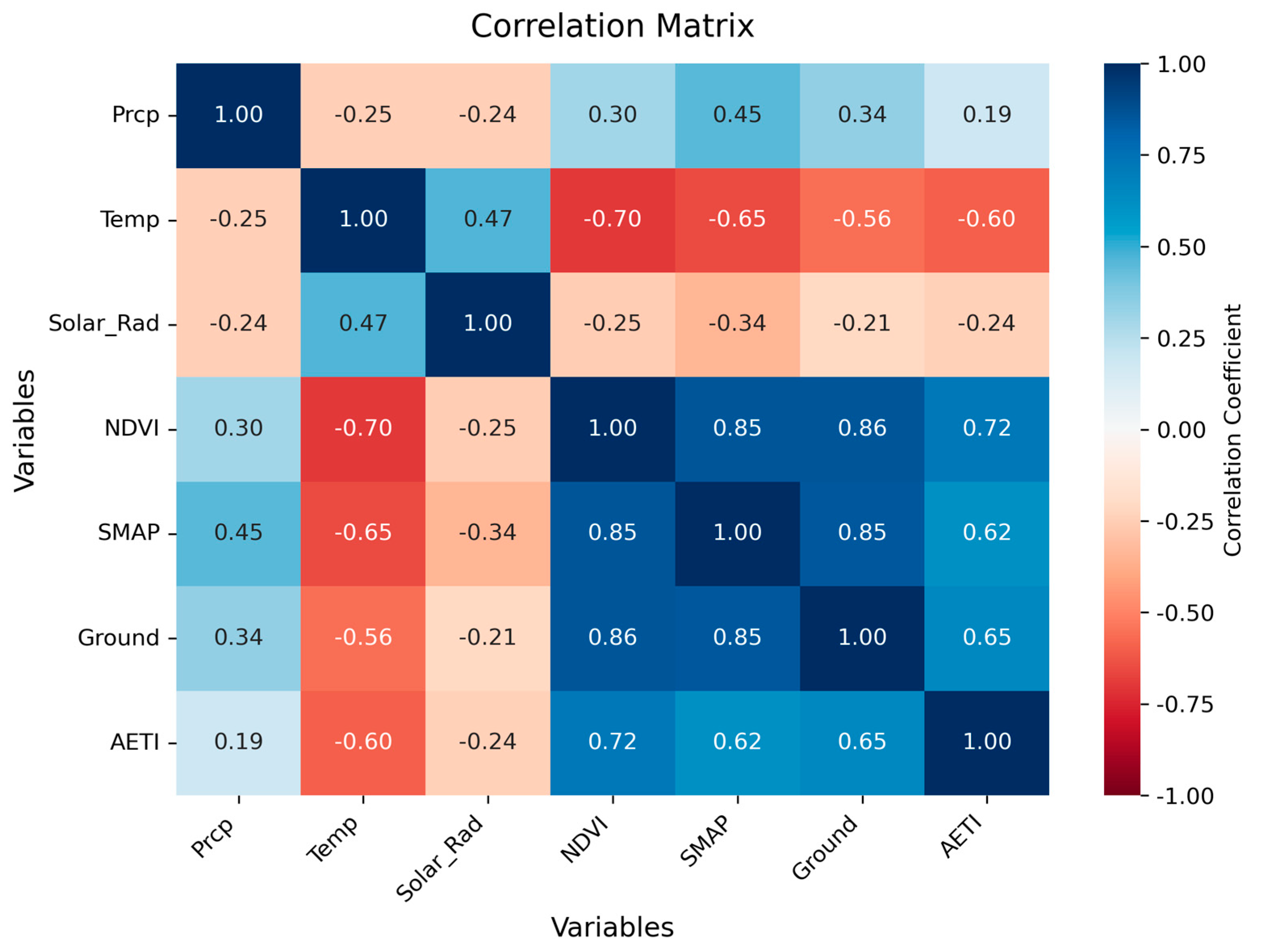
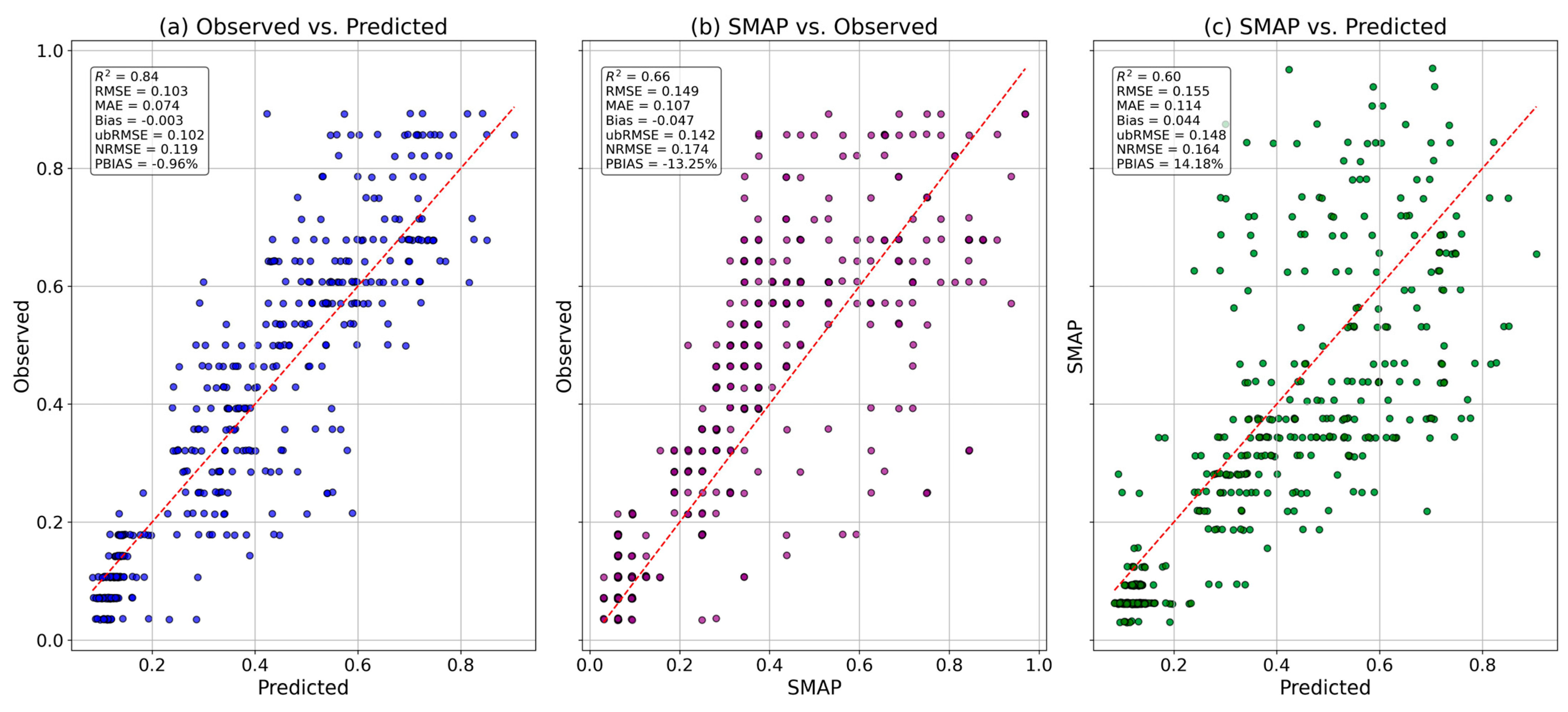
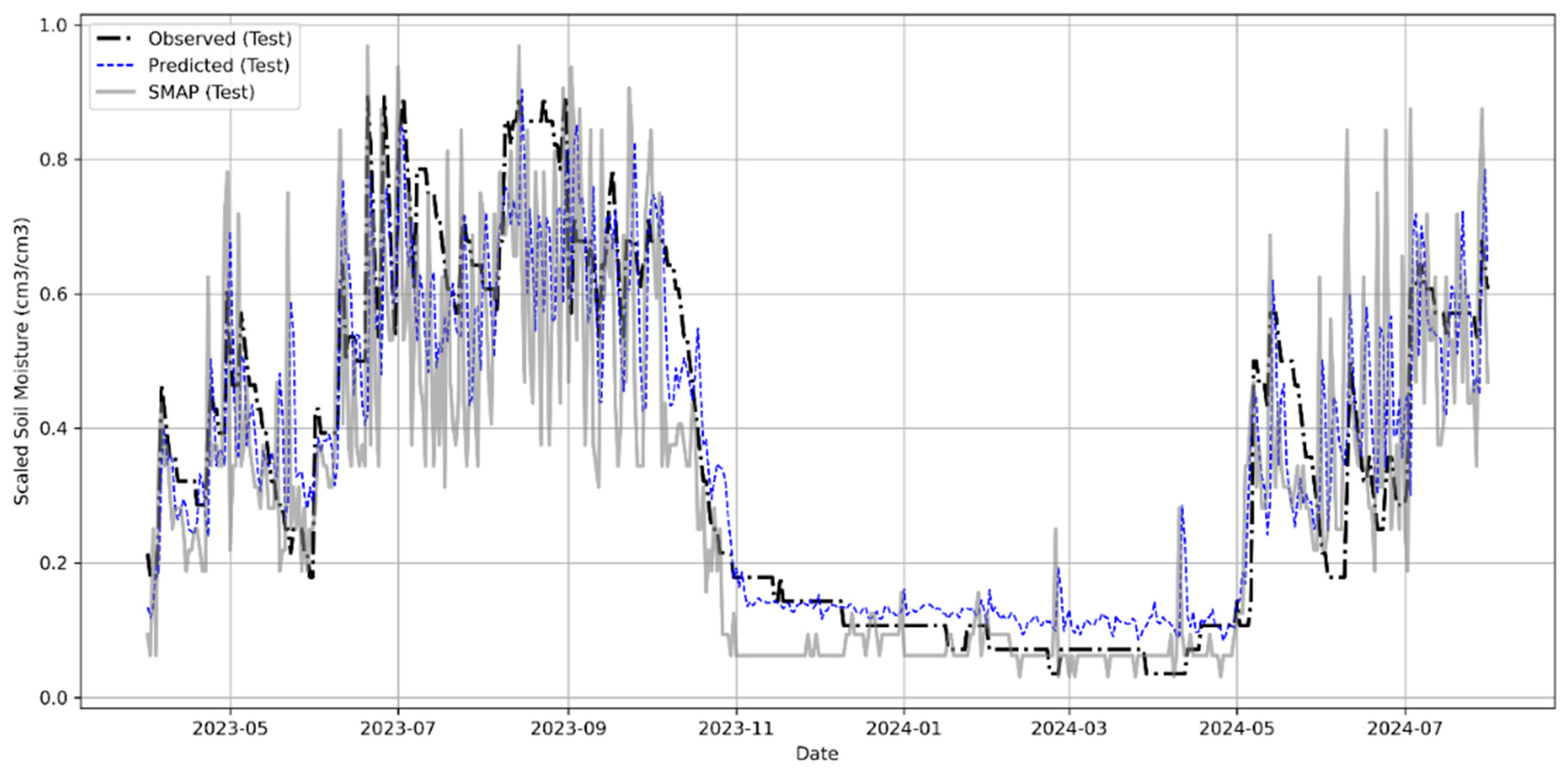
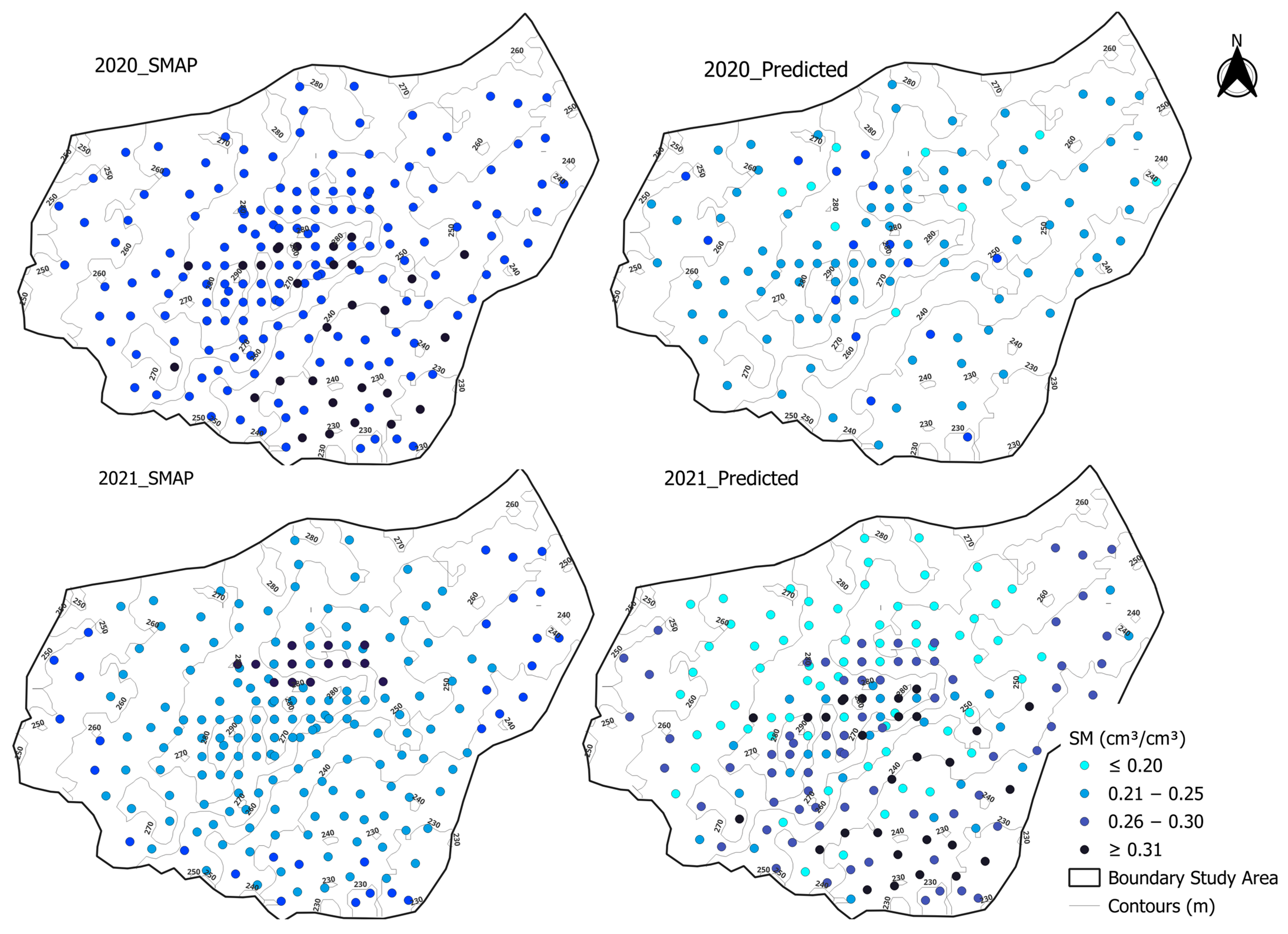

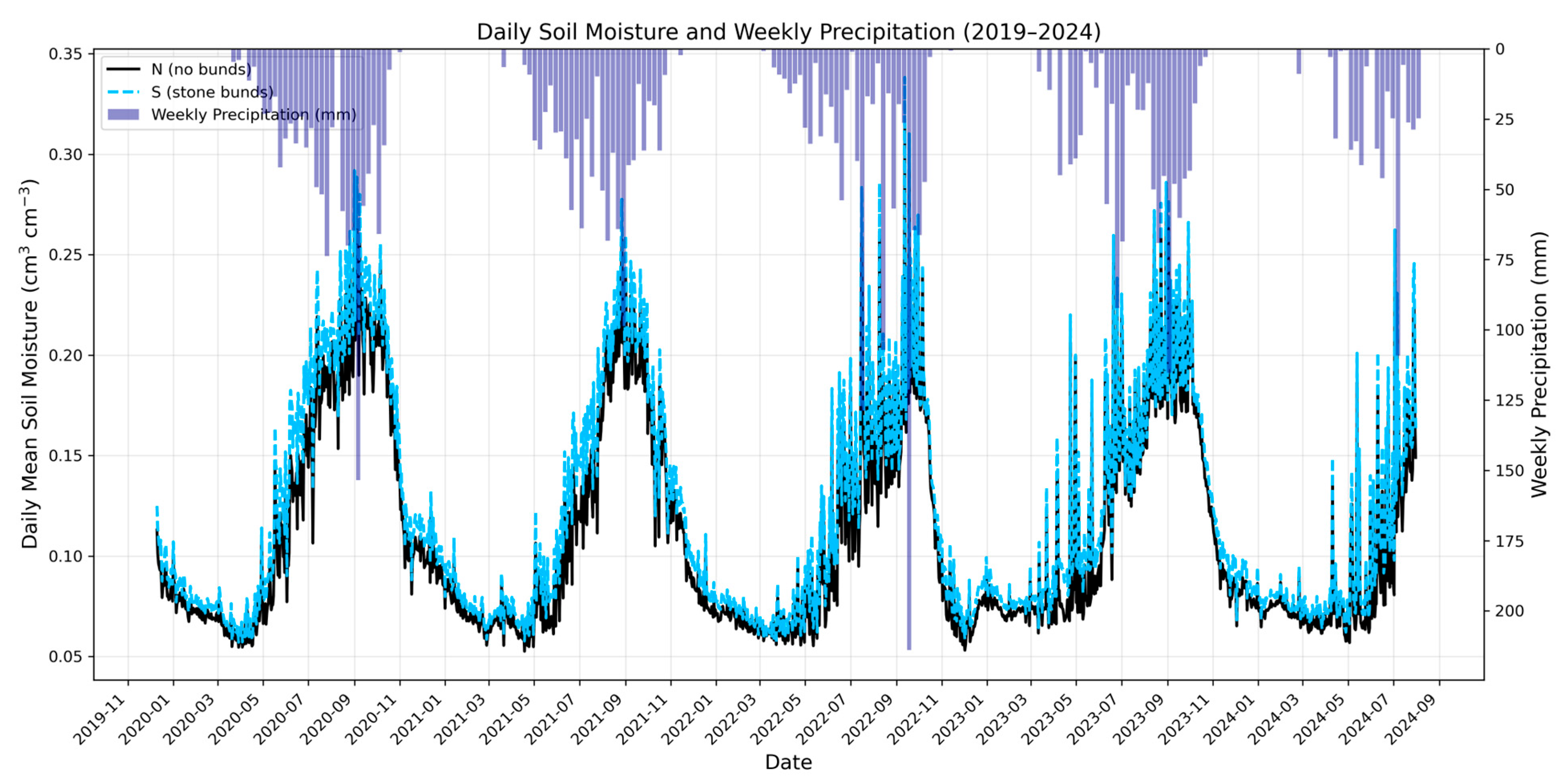

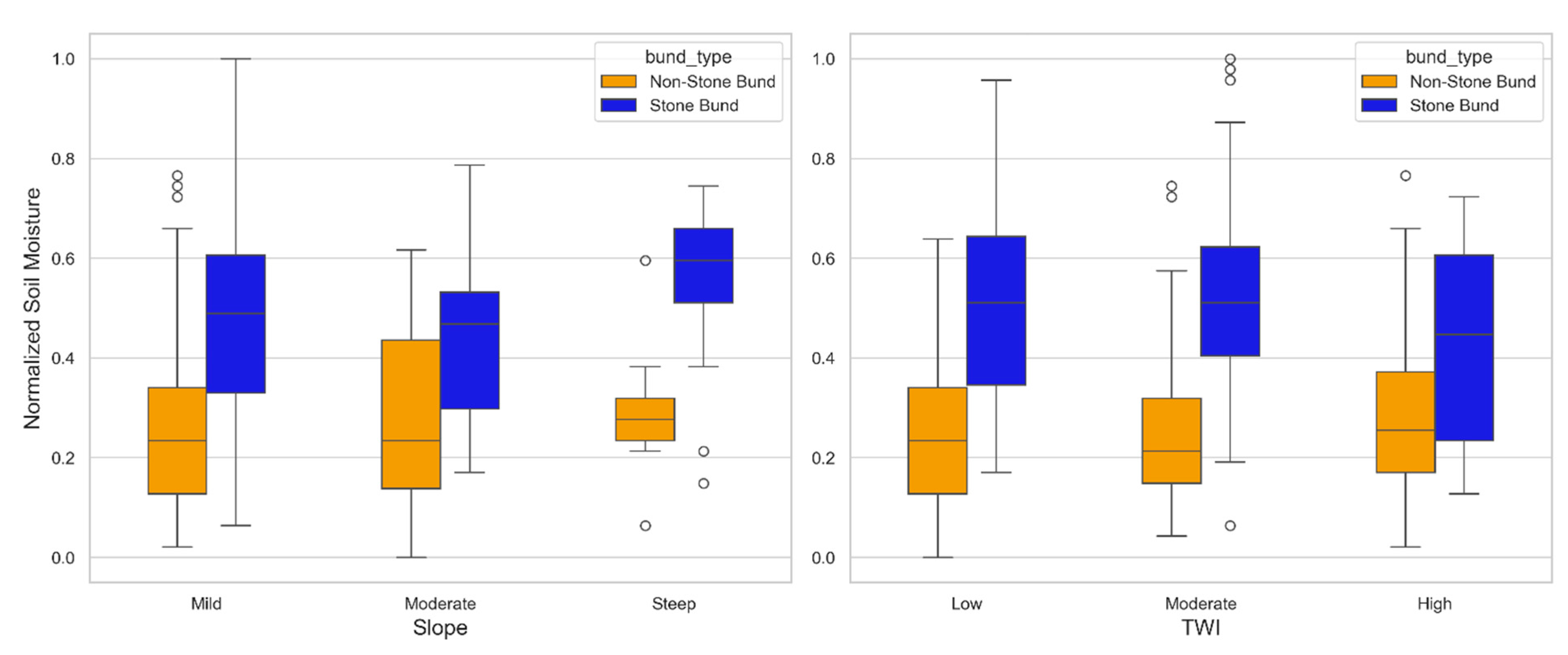
| Category | Stone Bunds (S) | Without Stone Bunds (N) | |
|---|---|---|---|
| Slope | Steep (>10%) | 16 | 9 |
| Moderate (5–10%) | 13 | 19 | |
| Mild (0–5%) | 71 | 94 | |
| Elevation | High (>270 m) | 37 | 35 |
| Moderate (231–270 m) | 57 | 56 | |
| Low (≤230 m) | 6 | 31 | |
| TWI | High (>4) | 15 | 35 |
| Moderate (3–4) | 56 | 38 | |
| Low (≤2) | 29 | 49 | |
| Total number of sites | 100 | 122 | |
| Variable | Unit | Source | Description |
| Air temperature (T) | °C | Local weather station (WatchDog 2800) | Atmospheric control on evaporation |
| Precipitation (P) | mm day−1 | Water input to soil | |
| Reference evapotranspiration (ET0) | mm day−1 | Computed (FAO-56 Penman–Monteith) | Atmospheric demand indicator |
| Day of Year (DOY) | - | - | Seasonal indicator |
| Parameter | Description | Value |
|---|---|---|
| Number of LSTM layers | Hidden recurrent layers | 1 |
| Units (neurons) | Nodes in the LSTM layer | 64 |
| Activation function | Nonlinear function applied to hidden state | tanh |
| Dropout rate | Fraction of neurons dropped during training | 0.1 |
| Optimizer | Optimization algorithm | Adam |
| Learning rate | Step size for weight updates | 0.00113 |
| Batch normalization | Applied after LSTM layer | Yes |
| Sequence length | Number of previous days used as input | 30 |
| Batch size | Samples per gradient update | 32 |
| Epochs | Number of training iterations | 50 |
| Early stopping | Patience (epochs without improvement) | 10 |
| Metrics | SMAP (1 km) | SMAP (9 km) | NASA Power |
|---|---|---|---|
| Correlation coefficient (r) | 0.802 | 0.901 | 0.894 |
| Coefficient of Determination (R2) | 0.643 | 0.812 | 0.799 |
| Nash–Sutcliffe Efficiency (NSE) | 0.588 | −4.396 | −4.093 |
| Root Mean Square Error (RMSE) | 0.056 | 0.202 | 0.197 |
| Mean Absolute Error (MAE) | 0.036 | 0.121 | 0.116 |
| Bias | 0.002 | 0.12 | 0.115 |
| Mean | 0.127 | 0.245 | 0.24 |
| Median | 0.091 | 0.12 | 0.12 |
| Standard Deviation (σ) | 0.090 | 0.237 | 0.233 |
| Season | Model | R2 | RMSE | MAE | ubRMSE | NRMSE | Bias | PBIAS |
|---|---|---|---|---|---|---|---|---|
| Dry | LSTM | 0.76 | 0.05 | 0.04 | 0.05 | 0.09 | 0.02 | 13.66 |
| Dry | SMAP | 0.54 | 0.07 | 0.05 | 0.06 | 0.12 | −0.03 | −20.09 |
| Wet | LSTM | 0.58 | 0.13 | 0.10 | 0.13 | 0.17 | −0.02 | −3.80 |
| Wet | SMAP | 0.11 | 0.19 | 0.15 | 0.18 | 0.24 | −0.06 | −11.92 |
Disclaimer/Publisher’s Note: The statements, opinions and data contained in all publications are solely those of the individual author(s) and contributor(s) and not of MDPI and/or the editor(s). MDPI and/or the editor(s) disclaim responsibility for any injury to people or property resulting from any ideas, methods, instructions or products referred to in the content. |
© 2025 by the authors. Licensee MDPI, Basel, Switzerland. This article is an open access article distributed under the terms and conditions of the Creative Commons Attribution (CC BY) license (https://creativecommons.org/licenses/by/4.0/).
Share and Cite
Tefera, M.L.; Zeleke, E.B.; Pirastru, M.; Melesse, A.M.; Seddaiu, G.; Awada, H. Satellite-Based Machine Learning for Soil Moisture Prediction and Land Conservation Practice Assessment in West African Drylands. Remote Sens. 2025, 17, 3651. https://doi.org/10.3390/rs17213651
Tefera ML, Zeleke EB, Pirastru M, Melesse AM, Seddaiu G, Awada H. Satellite-Based Machine Learning for Soil Moisture Prediction and Land Conservation Practice Assessment in West African Drylands. Remote Sensing. 2025; 17(21):3651. https://doi.org/10.3390/rs17213651
Chicago/Turabian StyleTefera, Meron Lakew, Ethiopia B. Zeleke, Mario Pirastru, Assefa M. Melesse, Giovanna Seddaiu, and Hassan Awada. 2025. "Satellite-Based Machine Learning for Soil Moisture Prediction and Land Conservation Practice Assessment in West African Drylands" Remote Sensing 17, no. 21: 3651. https://doi.org/10.3390/rs17213651
APA StyleTefera, M. L., Zeleke, E. B., Pirastru, M., Melesse, A. M., Seddaiu, G., & Awada, H. (2025). Satellite-Based Machine Learning for Soil Moisture Prediction and Land Conservation Practice Assessment in West African Drylands. Remote Sensing, 17(21), 3651. https://doi.org/10.3390/rs17213651







